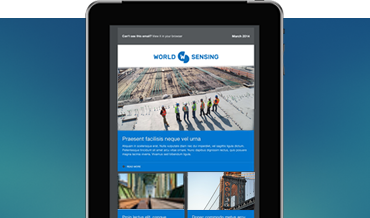How LoRa star technology helps to monitor tunnel building and operation
Tunnel monitoring is a major part of engineering. In the United States, for example, tunnels represent a market worth $5 billion, involving more than 700 businesses. Germany, meanwhile, saw 190 kilometers of new tunnels being built in 2018. This construction work is particularly complex because of the risk of cave-ins, rockfalls, flooding and other hazards. Hence, it makes sense for engineering and construction firms to adopt state-of-the-art monitoring technology. Yet one of the best options is still lagging in adoption.
That is a key finding from a Worldsensing webinar on tunnel monitoring, featuring Alexandre Cosentino, Project Management Engineer at GKM Consultants, and Maria Navarro Alonso, Technical Office Engineer at Worldsensing. In an audience poll, it emerged that only 23% of attendees were using monitoring technologies based on LoRa, a low-power, long-range communications protocol especially suited to tunnel monitoring. A further 14% of respondents were not sure of the technology in use in their operations.
“Monitoring tunnel construction can be done in several ways, through manual or automatic systems, which can be wired or wireless,” said Navarro. “Focusing on wireless technology, there are several technologies that can be suitable according to the type of the project.”
Tunnel monitoring options
These include technologies based on local area networks (LANs), such as ZigBee, Bluetooth and WiFi. These are mostly applicable for projects where wireless communication is only needed for short distances, say up to 100 meters, which rules out their use in major tunneling projects. Another option is to use cellular technologies such as 3G and 4G. These can reach longer distances and allow for frequent data collection—but have high power consumption rates.
This limits the time during which battery-operated sensors can work in the field unless sensor data is only sent sporadically—say, once a day—which then curtails the engineering team’s ability to monitor the tunnel environment in real time. Cellular technologies also depend on the availability of public cellphone networks and having line of sight to a cell tower, which might be hard to achieve during tunnel construction.
LoRa, on the other hand, “is based on Internet of Things technology and addresses the issues of LAN and cellular technologies on range and power consumption,” said Navarro. “With this low-power, wide area network technology, data can be transmitted over large distances while only needing very little power.”
Why LoRa star is best for monitoring
Worldsensing’s product family, which comprises edge devices, communications and network management, is based on LoRa technology and is compatible with a wide range of geotechnical, geospatial and structural sensors. The equipment is robust, reliable and simple to set up, making it ideal for challenging construction environments. Worldsensing networks use star topologies to optimize the energy use of edge devices.
The networks can be based on a single-gateway architecture using Worldsensing’s Connectivity Management Tool (CMT) Edge software, with sensor data being transferred a single gateway and pushed to third-party systems if needed. Alternatively, it is possible to put together multi-gateway architectures using CMT Cloud. “This architecture brings a lot of advantages,” said Navarro. “It decreases the risk of data loss, simplifies management and implies more processor capacity.”
To find out more, watch the webinar now.

